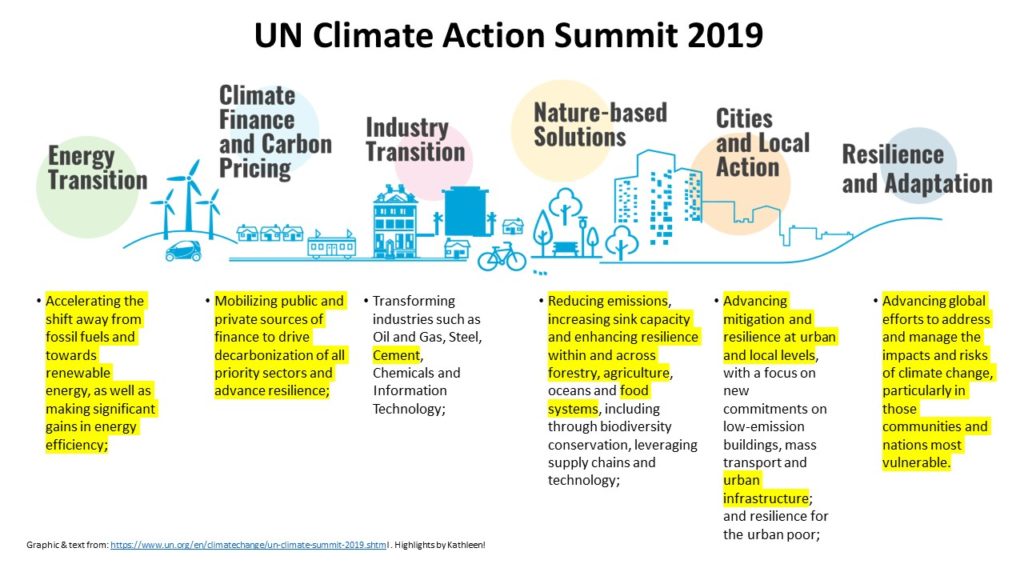
The UN is hosting a Climate Action Summit in NYC in September with a catchy title of “A Race We Can Win”. One would hope that emphasizing optimism over the ever escalating doom will be a more effective motivator to shift quickly from planning to action! The summit will highlight and promote the adoption of ambitious climate actions that will help countries to achieve their Nationally Determined Contributions (NDCs). Using the 6 key areas they are focusing on, allow me to highlight a few examples that demonstrate how biochar can provide solutions within each area.
Energy Transition: An increasing number of pyrolysis and gasification technologies are displacing heat or electricity formerly produced by fossil fuels. Pyreg, a German pyrolysis manufacturer has more than 2 dozen installations throughout Europe that are converting biomass into heat and biochar. Syncraft, an Austrian company that produces gasifiers for electricity production which can also produce high quality biochar in varying amounts to meet market demand, is expanding rapidly beyond Austria to Germany, Croatia and Japan.
Climate Finance & Carbon Pricing: Carbon offset markets have traditionally locked out biochar for various reasons. Given that many of these markets are over-subscribed and undervalued, not being included in these marketplaces hasn’t really been a game changer for the biochar industry (though many in the industry might disagree with me). The urgency for negative emissions technologies, highlighted in the IPCC’s Special Report, is spurring the development of carbon removal markets (perhaps we should call them Carbon Safety Deposit Banks?). The number of products and/or projects capable of sequestering carbon is much smaller than the number of products that can offset fossil fuel emissions which obviously plays in biochar’s favor. Removal marketplaces to keep an eye on include: Nori, Puro which just launched in Finland, and the Carbon Leasing Program being developed by European biochar producers that produce certified biochars.
Industry Transition: High emitting industries such as cement may be able to decarbonize using the heat from biochar production instead of using fossil fuels, as well as by adding biochar to cement to improve certain qualities and sequester carbon. Displacing other high carbon ingredients such as carbon black, activated carbon made from coal, or graphite is another way to reduce emissions across many different industries (more on that in BURN: Using Fire to Cool the Earth).
Nature-based Solutions: As noted already, biochar production can be viewed as an offset for fossil fuel energy production. It also provides long term carbon storage which can benefit forests, agriculture (through improved soil fertility, water management, etc.), oceans (by reducing nutrient run-off which causes dead zones) and food systems (by immobilizing heavy metals in soils making food safer or by improving soils more food is produced).
Cities & Local Action: Urban infrastructure has paved over vast amounts of land leaving fewer safe places for heavy rain to go. Using structured soils that combine biochar, compost and gravel can increase water drainage capacity substantially and reduce the impact of toxins that often result from flooding. Cities such as Stockholm have been replacing heavy clay soils with specially designed structured soils to help reduce stormwater quantity and to filter out toxins. Other cities are beginning to follow their lead.
Resilience & Adaptation: Foresters are converting infected or dying trees into biochar and using the biochar to replant forests that have gone up in flames. Farmers are converting crop and livestock residues into biochar and blending it with other organic wastes which can reduce or eliminate the need for chemical fertilizers…which is better for their bottom line, better for their soils and better for rebalancing carbon…while seeing yields increase even during periods of drought.
The bright spots for biochar production and use are out there and multiplying quickly. I’ve endeavored to highlight some of them through this blog, through BURN (webinar on the book coming up on Friday, sign up here), through white papers (e.g. coffee cultivation & biochar) through biochar webinars and by organizing biochar study tours (join me on the next one in Finland Sept 4 – 6). What is needed now are detailed biochar scale up plans showing communities, countries and industries what technologies are already available to carbonize crops and decarbonize economies and how they can be implemented. Done right, this not only helps meet NDCs but can create vibrant, resilient regional economies.

